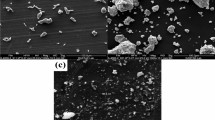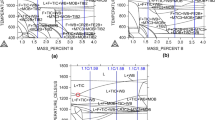A cermet of the Al-α-Al2O3 composition (90 vol.%) was prepared using hollow corundum microspheres (HCM) of a narrow fraction of 40 – 70 μm, which were obtained by plasma spheroidization, and PAP-2 aluminum powder. During liquid-phase sintering of the starting powder materials, adhesive bonding was created along the boundary between HCM and PAP-2 as a result of crystallization of the Al–Al4C3 eutectic melt. The resulting cermet demonstrates the following characteristics: density 2.67 – 2.89 g/cm3, open porosity 19 – 11%, bending strength 47 – 70 MPa, compression strength 100 – 150 MPa, Vickers microhardness 1550 – 1960 MPa, impact bending strength 3.53 × 103 – 4.27 × 103 J/m2, and fracture toughness 1.7 – 2.9 MPa·m1/2. The developed material can be recommended as an abrasive tool for smoothing the surface of metal and metal alloy parts during their finishing treatment.









Similar content being viewed by others
References
W. Zhu, Y. Cui, and C. Li, “Effects of alumina hollow microspheres on the properties of water-borne polyurethane films,” J. Mater. Res., No. 33, 2486 – 2493 (2018).
E. A. Pavlycheva, “Development of a heat-resistant polymer composite material for technical thermal insulation,” [in Russian] Mezd. Zhurl. Priklad. i Fund. Issled., No. 7, 51 – 55 (2021).
Yu. M. Mikhailov, M. S. Reznikov, A. Sh. Mingazov, N. F. Ushmarin, and S. I. Sandalov, Composite Rubber Compound for Acoustic Coatings. Pat. Russian Federation 2690807, C 08 L 9/00. Bull. No 16. (2019).
Yu. A. Grigoriev, High-temperature Heat-Shielding Coating. Pat. Russian Federation 2482146. No 2011136161. Bull. No 14 (2013).
O. P. Solonenko, I. P. Gulyaev, and A. V. Smirnov, “Plasma treatment and spraying of metal oxide powders consisting of hollow spheres,” Pisma v ZhTF [in Russian], 34(24), 22 – 27 (2008).
F. Pedraza, B. Rannou, G. Boissonnet, et al., “Rheological behavior, synthesis and performance of smart thermal barrier coating systems based on hollow alumina,” Jour. of Mater. Sci. and Chem. Eng., 3(12), 17 – 22 (2015).
N. Zhenguei and Yu. Lin, “Fabrication of porous alumina ceramics using hollow microspheres as the pore-forming agent,” Journal of the KSMTE, 24(4), 368 – 373 (2015).
B. L. Krasny, V. P. Tarasovsky, A. B. Krasny, et al., “Heat-insulating refractory material based on hollow corundum microspheres,” Novye Ogneupory [in Russian], No. 12, 29 – 31 (2014).
R. Stonys, J. Malaiškiené, J. Škamat, and V. Antonovic, “Effects of hollow corundum microspheres additive on physical and mechanical properties and thermal shock resistance behavior of bauxite based refractory castable,” Materials, No. 14, 4736 – 4746 (2021).
M. Chatterjee, D. Enkhtuvshin, and B. Siladitya, “Hollow alumina microspheres from boehmite sols,” J. Mater. Sci., 33, 4937 – 4942 (1998).
C. Wei-Wei, Ya. Hui, and G. Xing-Zhong, “A facile one-step route to synthesize titania hollow microspheres with incontinuous multicavities,” Chin. Chem. Lett., 25(3), 441 – 446 (2014).
W. Ai-Juan, L. Yu-Peng, and S. Rui-Xue, “Recent progress on the fabrication of hollow microspheres,” Mater. Sci. Eng., A, 460/461(8), 1 – 6 (2007).
Zh. Jiabin, W. Lei, Zhang, Yu Jiaguo, “Facil synthesis of alumina hollow microspheres via trisodium citrate-mediated hydrothermal process and their adsorption performances for p-nitrophenol from aqueous solution,” J. Colloid Interface Sci., 394, 509 – 514 (2013).
M. Yu-Xin, “Alumina hollow microspheres supported gold catalysts for low-temperature co oxidation: effect of the pretreatment atmospheres on catalytic activity and stability,” Gold Bull., No. 47, 275 – 282 (2014).
T. Kato, T. Masamutsu, S. Keigo, et al., “Preparation of hollow alumina microspheres by ultrasonic spray pyrolysis,” J. Ceram. Soc. Jpn., 110(3), 146 – 148 (2002).
T. Kato, H. Ushijima, and M. Katsumata, “Fabrication of hollow alumina microspheres via core/shell structure of polimethylmethacrylate/alumina prepared by mechanofusion,” J. Mater. Sci., No. 37, 2317 – 2321(2002).
A. A. Vasin, Structure and Properties of Ceramics from Powders Obtained by Chemical Dispersion of an Aluminum-Magnesium Alloy with a High Content of Magnesium. Diss. cand. tech. sciences, Moscow (2015).
A. A. Tarasov, M. N. Kudryash, and D. A. Tarasov, Method for Producing Hollow Microspheres of Metal Oxides. Pat. 2663886 Russian Federation, C 03 B 19/1075, C 03 B 19/109. Bull. No. 23 (2018).
Yu. N. Tsvetkov, A. V. Samokhin, N. V. Alekseev, Yu. V. Astashov, et. al., Collection of Scientific Works of A. A. Baykov Institute of Metallurgy and Materials Science, Moscow, Interkontakt Nauka (2018).
Yu. N. Tumanov, Plasma, High-Frequency, Microwave and Laser Technologies in Chemical-Metallurgical Processes, Moscow, Fizmatlit (2010).
J. Kraxner, J. Chovanec, K. Haladejová, et. al., “Hollow polycrystalline YAG microspheres by flame synthesis,” Mater. Lett., 204, 181 – 183 (2017).
M. Y. He, B. Wu, and F. W. Zok, “On the mechanics of microballoon — reinforced metal matrix composites,” Mech. Mater., 20(4), 315 – 328 (1995).
M. Y. He, M. Kiser, B. Wu, and F.W. Zok, “Influence of thermal expansion mismatch on residual stresses and flow response of microbaloon composites,” Mech. Mater., 23(2), 133 – 146 (1996).
X. F. Tao, L. P. Zhang, and Y. Y. Zhoe, “Al matrix syntactic foam fabricated with bimodal ceramic microspheres,” Materials and Desing., 30 (7), 2732 – 2736 (2009).
D. K. Balch, J. G. O’ Dwyer, G. T. Gray, and D. C. Dunand, “Plasticity and damage in aluminum syntactic foams deformed under dynamic and quasi – static condition,” Mater. Sci. Eng., A, A391, 408 – 417 (2005).
J. A. Santa Maria, B. F. Schultz, J. B. Ferguson, and P. K. Rohatgi, “Al–Al2O3 syntactic foams. Part 1: Effect of matrix strength and hollow sphere size on the quasi-static properties of Al–A206/Al2O3,” Mater. Sci. Eng., A, A582, 415 – 422 (2013).
J. B. Ferguson, J. A. Santa Maria, B. F. Schultz, and P. K. Rohatgi, “Al–Al2O3 syntactic foams. Part II: Predicting mechanical properties of metal matrix syntactic foams reinforced with ceramic spheres,” Mater. Sci. Eng., A, A582, 423 – 432(2013).
I. N. Orbulov and K. Máliger, “Microstructure of metal-matrix composites reinforced by ceramic microballoons,” Mater. Technol., 46(4), 375 – 382(2012).
D. A. Ivanov, “Investigation of physical-mechanical properties and structure of layered cermet Al-Al2O3- Al4C3,” Refract. Ind. Ceram., 61(4), 393 – 398 (2020).
D. A. Ivanov, G. E. Val’yano, T. I. Borodina, “The structure and phase composition of the cermet charge in the Al–Al2O3 system obtained using mechanical processing of aluminum powder in a planetary ball mill,” Refract. Ind. Ceram., 62(3), 324 – 331 (2021).
D. A. Ivanov and A. I. Sitnikov, Composite Materials: Textbook for Universities, Moscow, Yurayt (2019).
Author information
Authors and Affiliations
Corresponding author
Additional information
Translated from Novye Ogneupory, No. 4, pp. 20 – 26, April, 2022.
Rights and permissions
Springer Nature or its licensor (e.g. a society or other partner) holds exclusive rights to this article under a publishing agreement with the author(s) or other rightsholder(s); author self-archiving of the accepted manuscript version of this article is solely governed by the terms of such publishing agreement and applicable law.
About this article
Cite this article
Ivanov, D.A., Tarasov, D.A., Kudryash, M.N. et al. Physico-Mechanical Properties and Structual Features of an Al–α–Al2O3 Cermet Obtained Using Corundum Microspheres by Sintering in Vacuum. Refract Ind Ceram 63, 209–214 (2022). https://doi.org/10.1007/s11148-022-00708-7
Received:
Published:
Issue Date:
DOI: https://doi.org/10.1007/s11148-022-00708-7




